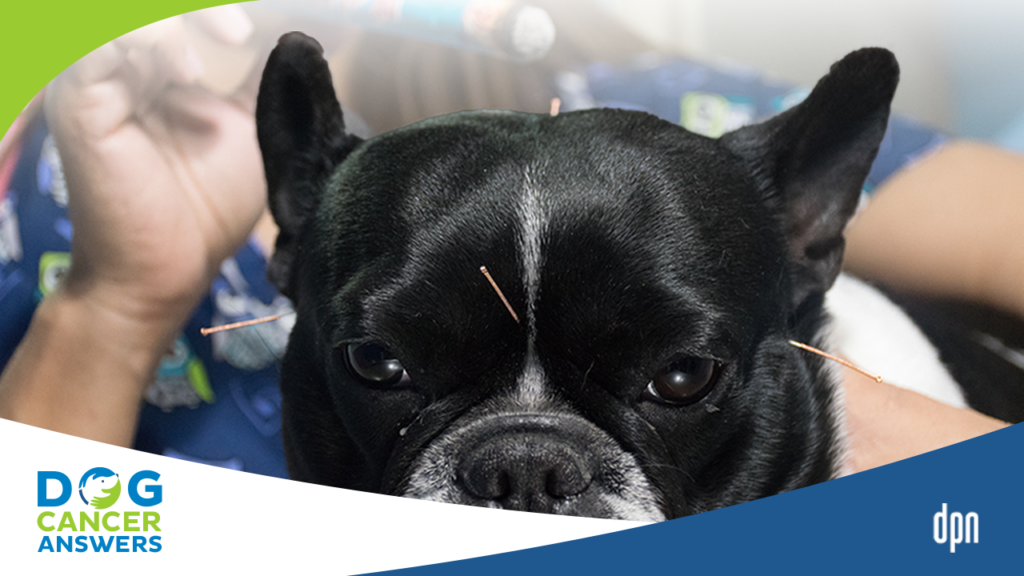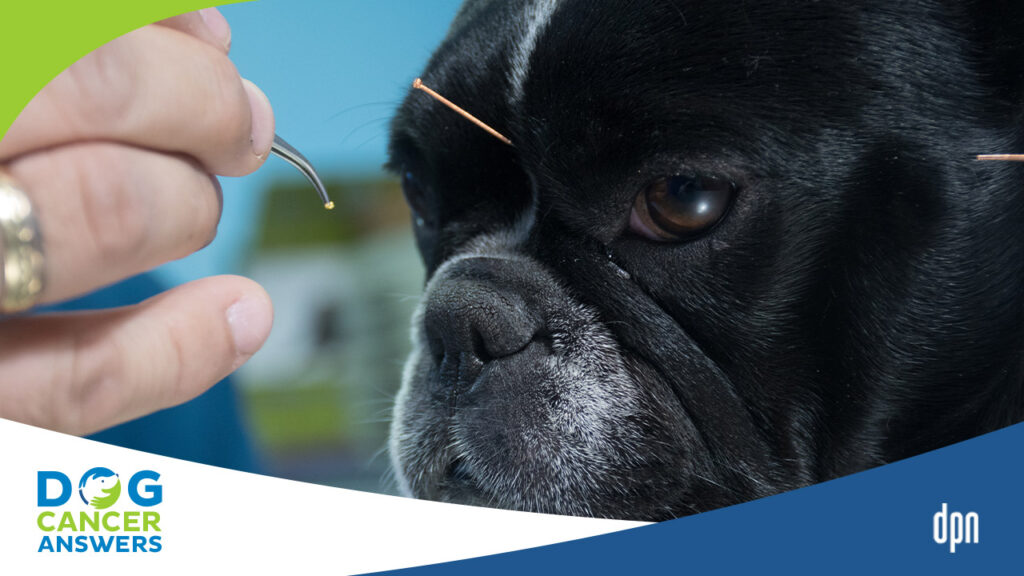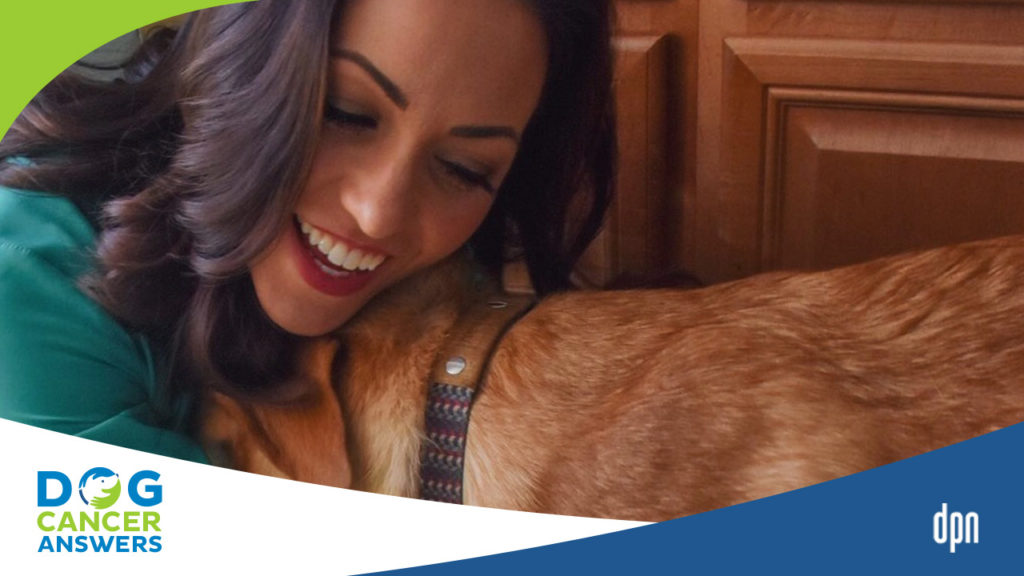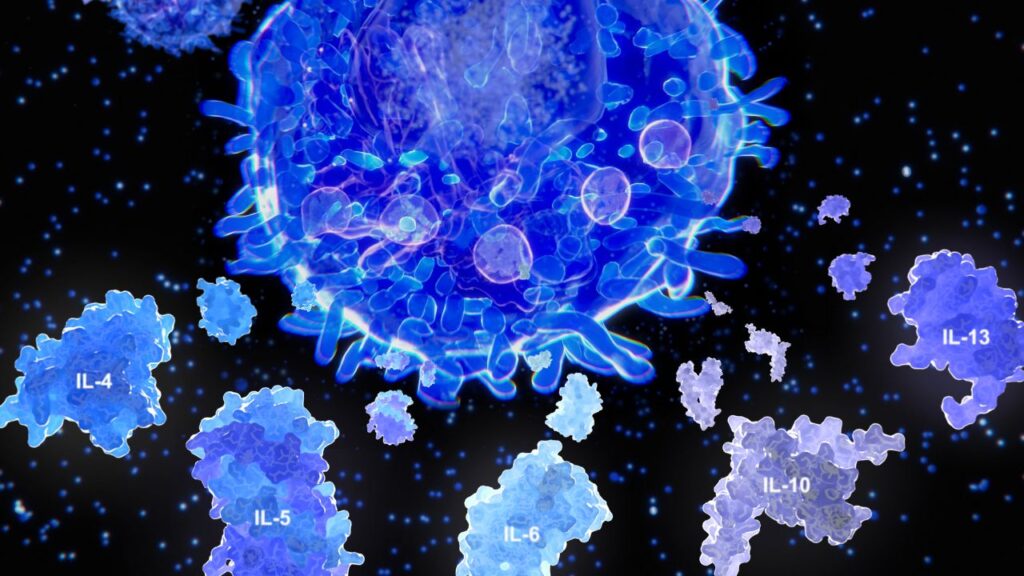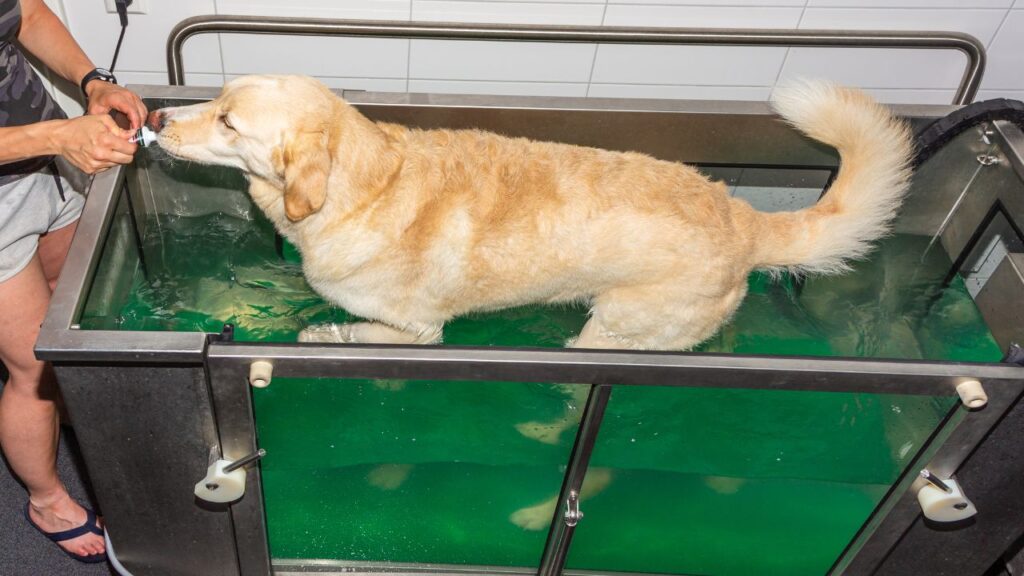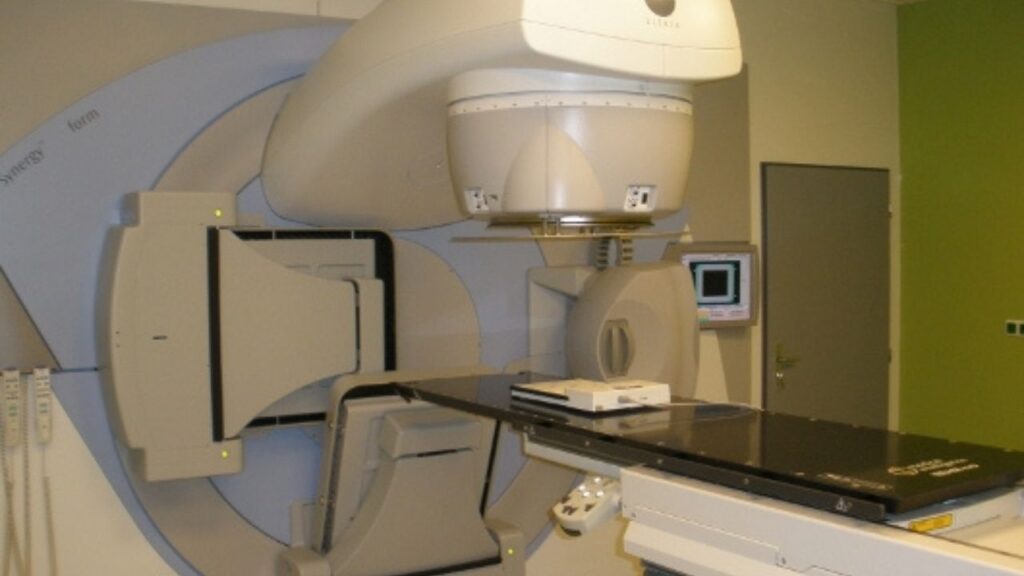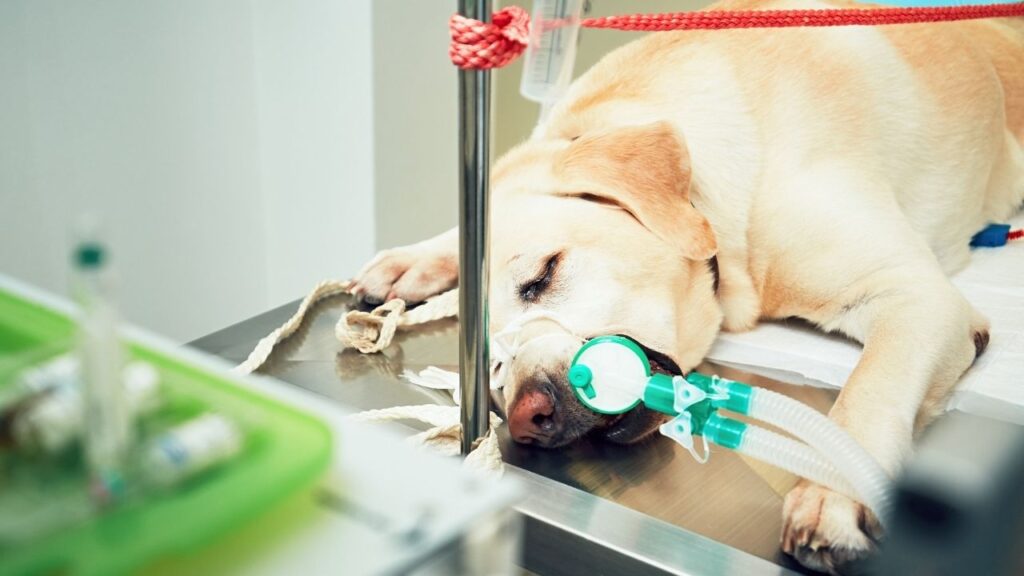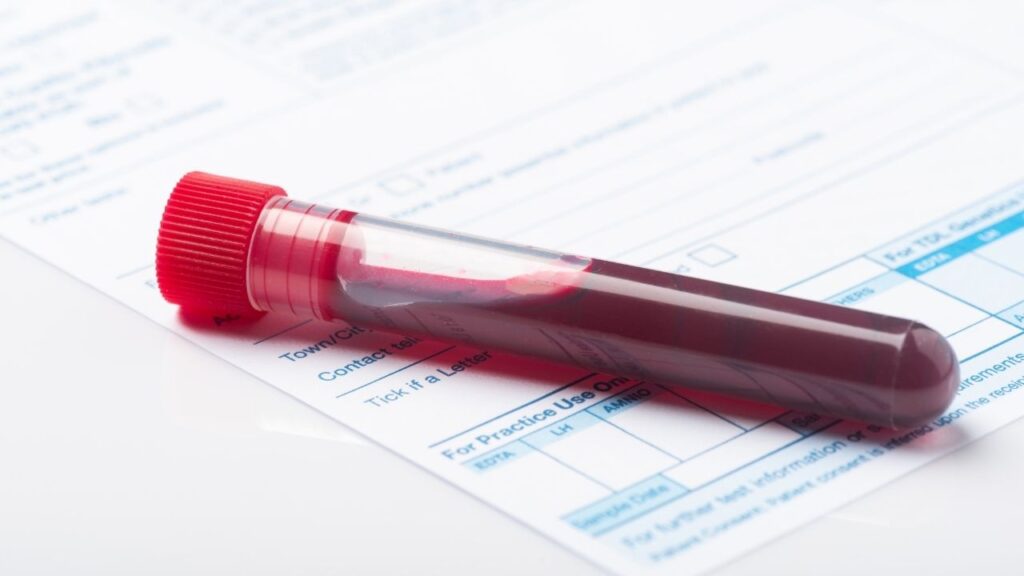Acupuncture is an effective adjunct to other cancer treatments, acting to stimulate the cancer fighting properties of the immune system and alleviate some side effects of chemotherapy.
Key Takeaways
- Yes, acupuncture really works on dogs!
- How often a dog should get acupuncture depends on their health condition and where they are in the treatment process. Often treatments are once or twice a week at first, and then spread out over time.
- Common side effects of dog acupuncture include fatigue, soreness, and minor bleeding or bruising.
- Veterinary acupuncture works by stimulating the nerves at specific locations to achieve the desired effects.
- A dog might need acupuncture for pain relief, nausea, poor appetite, or stimulating the immune system.
What Happens During Acupuncture for Dogs
During an acupuncture treatment, very thin needles are placed into specific locations of the body. These points are called acupoints or acupuncture points.
Acupuncture has been used for thousands of years as a staple of Traditional Chinese Medicine (TCM).4 Acupuncture is used to restore proper balance within the body and alleviate the health problems resulting from imbalance.
From a Western medicine standpoint, acupuncture points are generally located in areas with bundles of nerve endings and blood vessels, and stimulating these areas has been shown to improve circulation and promote the production and release of endorphins, the body’s natural pain relievers.3
There are hundreds of identified acupuncture points and each one is associated with specific actions in the body. The affect of stimulating a particular point depends on where the nerve(s) in that spot started and where they go to.
Points are chosen based on their actions, the desired outcome, and the tolerance level of the dog. For example, there are points on the legs, paws, and along the spine that can all be used to treat nausea, but most dogs tolerate needle placement along the legs and spine better than in the paws, so your veterinarian may choose to use the spinal points instead of the paw points.
The number of needles used will vary based on the dog’s tolerance level and the veterinarian’s training, but will usually be somewhere between 5 and 30 needles. Once the needles are placed, they are usually left in place for 15-45 minutes depending on the patient and the goals of the session.
Variations of acupuncture that may be performed include:
- Electroacupuncture, where a low level of electrical stimulation is applied to the needles to enhance the stimulation.
- Aquapuncture, where a small amount of sterile liquid – traditionally vitamin B12, or a homeopathic liquid or the patient’s own blood – is injected into the acupuncture points to evoke a stronger response.
- Moxibustion, where a heat source (a burning moxa stick) is applied to the needles to warm the area being treated and enhance the stimulation of the needles.
- Laser acupuncture, where a low-level laser (“cold” laser) is used over acupuncture points.
- Acupressure, where gentle pressure, usually using one finger, is applied to certain acupuncture points for several minutes.
It is usually recommended to get acupuncture treatments once or twice a week for at least 4-8 treatments to best assess the patient’s response to the treatment and build a cumulative effect. Once the patient has improved, treatments will usually be spread out further with the goal of treating as infrequently as possible while maintaining an acceptable level of improvement.
Acupuncture can't cure cancer, but it can do a whole lot to help your dog feel better and alleviate side effects from illness and medications alike. Dr. Narda Robinson explains the science in this episode of Dog Cancer Answers.
Benefits of Acupuncture for Dogs
Acupuncture has been shown to have direct benefits for managing the side effects of cancer treatments and, in some cases, fighting cancer itself. Below are some common uses for acupuncture in cancer patients and some examples of acupuncture points that are commonly associated with helping these conditions.
Pain management and inflammation
Acupuncture is best known and highly effective for its use in alleviating pain and inflammation17 in both the bones/joints and the soft tissues.
- Common points for pain and inflammation: ST-36, LIV-3, BL-60, LI-4, LI-11, GV-14 14,17
Nausea, vomiting, and diarrhea
Acupuncture is well known for helping manage these gastrointestinal (GI) upsets15,16, which are often side effects of medications, surgery, and chemotherapy, or may be noticed as symptoms of the cancer itself.
- Common points for GI upset: GV-1, ST-36, BL-20, BL-21, LI-4, LI-11, LI-10, PC-6, GB-34 16,18
Inappetence
Loss of appetite is common in dogs with cancer and as a side effect of cancer treatments. Acupuncture may improve your dog’s appetite.18
- Common points for inappetence/anorexia: BL-20, BL-21, CV-12, ST-36, SP-6, CV-12 18
Low white blood cells (leukopenia)
White blood cells are often negatively affected by chemotherapy drugs and acupuncture has been shown to help improve white blood cell counts.7 Improving white blood cell counts boosts the immune system, helping the body to employ its own cancer fighting methods.
Acupuncture has been shown to enhance the function of helper T cells,5 stimulate natural killer cell activity,1 and enhance cytokine levels,5 which are immune signaling chemicals.
- Common points for immune system support: LI-4, LI-11, ST-36, GV-14, SP-6, SP-10, PC-6 7,18
So Many Options!
Keep in mind that there are nearly 200 acupuncture points identified in the dog and each point has multiple actions in the body, so protocols will vary. Points will be selected by your veterinary acupuncturist to address your dog’s unique needs, with some points being used to treat more than one issue, and more than one point used to treat the same issue.
Your dog’s personality, tolerance of needle placement, and response to treatment will also dictate which points will be used at any given time. For example, if your dog is intolerant of having her paws touched, it is unlikely she will allow needling of points located in the paws, so other points with similar actions may be used instead.
When Acupuncture is Recommended
For patients with cancer, acupuncture may be recommended for managing symptoms of the cancer itself and managing the side effects of cancer treatments. In addition to its role in supporting the immune system and reducing pain, acupuncture can help alleviate GI issues such as nausea, vomiting, diarrhea, and inappetence.
If your dog’s cancer is not treatable with traditional means, or you choose not to pursue conventional treatments, acupuncture may still be a worthwhile endeavor to help improve and maintain your dog’s quality of life.
While most veterinary patients tolerate acupuncture well, the dog’s personality should be kept in mind. If the dog does not tolerate needle placement or cannot stay still long enough for treatment, another method such as acupressure or laser acupuncture may be a better fit.
Hear how integrative oncologist Dr. Kendra Pope uses oncology, acupuncture, herbs, and nutrition to fight dog cancer today in this episode of Dog Cancer Answers.
How Acupuncture Works
Though the mechanism of action of acupuncture is not completely understood, research is ongoing to uncover more about how it works. We do know that many acupuncture points are located in areas with converging bundles of nervous tissue and blood vessels, and that stimulating these areas causes changes in the nervous, circulatory, musculoskeletal, and immune systems.
Some of the better-understood effects of acupuncture in the body include:
Neural influences. Stimulating certain acupuncture points activates certain regions of the brain8, 9 and needle stimulation causes the release of endorphins and neurotransmitters.10
Immune system. Acupuncture inhibits inflammation11 and stimulates natural killer cell activity in rats. 1 These cells play a role in immune surveillance and can recognize and kill cancerous cells.
Connective tissues. When an acupuncture needle is inserted and rotated, connective tissue winds itself around the needle. This in turn transmits a signal to the connective tissue cells which results in a cellular response and the release of neuropeptides.12,17
Pain management. Acupuncture promotes the release of the body’s natural pain killers (endorphin and enkephalin), activates pain inhibiting pathways14, and reduces inflammation.11 The needles also cause a tiny trauma at the needle site, which causes the body to activate its natural healing processes.14, 17
Acupuncture for Dogs with Cancer
There are few formal studies of acupuncture in veterinary oncology patients, and most of the information we have on its benefits for cancer in dogs is extrapolated from human oncology studies.
While most studies to date are small and have some limitations, acupuncture is safe and well-tolerated, and shows promise as a more mainstream adjunct to conventional treatments. Some studies have been performed using acupuncture as part of the treatment plan for specific cancers.
Human Studies
- In women with ovarian cancer, acupuncture increased white blood cell numbers.7
- Women with mammary cancer undergoing chemotherapy had fewer vomiting episodes with electroacupuncture than with antiemetic drugs alone.23
- Patients undergoing surgery for stomach cancer had less pain, lower opioid use, and less nausea when treated with electroacupuncture after surgery.24
Animal Studies
- In dogs undergoing surgery for mammary cancer, acupuncture reduced the amount of fentanyl needed for pain management during surgery.19
- Case studies using acupuncture and Chinese herbs (without conventional treatments) have been published on oral fibrosarcoma, oral squamous cell carcinoma, and nasal adenocarcinoma, all resulting in longer than expected survival times with good quality of life.20-22
- For mice with osteosarcoma, electroacupuncture early in the disease process significantly reduced tumor growth and lung metastasis (though later in the process, it increased tumor growth).6
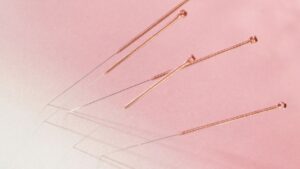
Acupuncture needles are tiny, but can have a big impact.
How to Get the Best Results from Acupuncture
For most patients and conditions, combining acupuncture treatments with conventional treatments is ideal. To get the best results from acupuncture, most veterinary acupuncturists will initially recommend treatments 1-2 times weekly for 4-8 treatments.13
Patients usually respond quickly, but acupuncture does tend to have a cumulative effect, so treatments are clumped together to build a longer-lasting response.
After the initial treatments, a schedule will be recommended by the veterinarian with the goal of treating as infrequently as possible while maintaining a satisfactory level of improvement. Depending on the practitioner and the behavior of the dog, needles are typically left in for 15-45 minutes and should be preceded by taking a history and performing a physical exam.
For pets who are not sitting still for the needed amount of time and keep knocking their needles out, aquapuncture may be a better option. Once the injections are made into the acupuncture point, the dog is free to go back home while the medication continues to activate the point. The treatment appointment can take less than five minutes.
Home Care
In general, no home care is needed. Some animals may be fatigued after treatment and should be allowed to rest. It has also been reported that some experience increased thirst so fresh water should be readily accessible.
Pets may continue to be tired for 24-48 hours after a session, and sometimes they will appear worse 24 hours later – this is actually a good sign that their body is responding well to the acupuncture. This response usually only lasts for the first or second session. If your dog is worse beyond 24 hours or if you have concerns, contact the acupuncturist. A pet who becomes worse with each session usually means there is something else going on that has not been discovered yet.
Follow Up Treatments
Recommended follow-up will depend on the patient’s tolerance level and response to treatment. In order to receive the best results, the initial treatments should be 1-2 times weekly for 4-8 treatments. After the initial treatments, the patient will be reassessed and the veterinarian will recommend a follow-up treatment schedule.13
Dr. Tori Countner believes in a holistic approach and treatments to help alleviate your dog’s anxiety and pain. She explains how she works alongside standard Western treatments to increase quality of life through acupuncture, cold laser therapy, nutrition, supplements, and lifestyle changes in this episode of Dog Cancer Answers.
When to Not Use Acupuncture
Acupuncture may be used in conjunction with most other therapies. It is a relatively safe treatment for dogs but there are a few cautions and contraindications.
Cautions:
- Caution should be used in pregnant animals.14
- Caution should be taken around the eyes.
- Caution should be taken with electroacupuncture in animals with a history of seizures.
- Caution should be used if the pet has severe or resistant skin infections.
- Caution in needle placement/points in lymphoma cases.
Contraindications:
- Electroacupuncture should not be used across the chest in animals with pacemakers, or across tumors. 14, 17
- Needles should not be placed directly into open wounds, tumors, or bone fractures.14
- Avoid acupuncture in dogs with clotting disorders14, and use caution for dogs on anticoagulants.
Where to Get Acupuncture for Dogs
Acupuncture should only be performed by a veterinarian who has been specifically trained in acupuncture. Most veterinary acupuncture certification programs require 130-140 hours of instruction, written and oral examinations, and internships and/or case reports.
There are currently only four institutions through which veterinarians can become certified in acupuncture:
- Chi University
- International Veterinary Acupuncture Society
- CuraCore Vet
- Canine Rehabilitation Institute
Each of these organizations’ websites, as well as the Animal Holistic Veterinary Medical Association, have listings of certified veterinary acupuncturists so you can find one near you.
Safety and Side Effects
Acupuncture is a relatively safe procedure when performed by a licensed and trained veterinarian. As with every medical procedure, however, there are some risks you should be aware of.
Common minor side effects include:
- Fatigue
- Soreness
- Minor bleeding or bruising
- Intolerance by the patient
More serious side effects are rare but may include:
- Infection
- Dermatitis
- Embedded needle fragments (if a needle breaks during treatment)
- Pneumothorax
- Foreign body (if a needle is swallowed)
- Hematoma, especially if the patient has a clotting disorder
- Pain with needling
- Aggravation of symptoms
Cost of Acupuncture
More than one acupuncture treatment is required to get the most benefit. Costs will vary depending on location, type of cancer or other health issue, frequency of visits, and duration of treatment. The typical cost of a single acupuncture session generally falls between $50 and $200. If a positive response is seen, long-term maintenance treatments are recommended.
- Sato T, Yu Y, Guo SY, Kasahara T, Hisamitsu T. Acupuncture stimulation enhances splenic natural killer cell cytotoxicity in rats. Jpn J Physiol. 1996;46(2):131-136. doi:10.2170/jjphysiol.46.131
- Chien TJ, Liu CY, Hsu CH. Integrating acupuncture into cancer care. J Tradit Complement Med. 2013 Oct;3(4):234-9. doi: 10.4103/2225-4110.119733.
- Acupuncture. Mayo Clinic. https://www.mayoclinic.org/tests-procedures/acupuncture/about/pac-20392763. Published April 30, 2022. Accessed December 1, 2022.
- Maurer N, Nissel H, Egerbacher M, Gornik E, Schuller P, Traxler H. Anatomical Evidence of Acupuncture Meridians in the Human Extracellular Matrix: Results from a Macroscopic and Microscopic Interdisciplinary Multicentre Study on Human Corpses. Evid Based Complement Alternat Med. 2019 Mar 21;2019:6976892. doi: 10.1155/2019/6976892.
- Chen L, Xu A, Yin N, et al. Enhancement of immune cytokines and splenic CD4+ T cells by electroacupuncture at ST36 acupoint of SD rats. PLoS One. 2017;12(4):e0175568. Published 2017 Apr 13. doi:10.1371/journal.pone.0175568
- Smeester BA, Al-Gizawiy M, O’Brien EE, Ericson ME, Triemstra JL, Beitz AJ. The effect of electroacupuncture on osteosarcoma tumor growth and metastasis: analysis of different treatment regimens. Evid Based Complement Alternat Med. 2013;2013:387169. doi:10.1155/2013/387169
- Lu W, Matulonis UA, Doherty-Gilman A, et al. Acupuncture for chemotherapy-induced neutropenia in patients with gynecologic malignancies: a pilot randomized, sham-controlled clinical trial. J Altern Complement Med. 2009;15(7):745-753. doi:10.1089/acm.2008.0589
- Xie H, Wedemeyer MA. The validity of acupuncture in veterinary medicine. Am J Trad Chinese Vet Med. 2012;7(1):35-43.
- Zhao ZQ. Neural mechanism underlying acupuncture analgesia. Prog Neurobiol. 2008;85(4):355-375. doi:10.1016/j.pneurobio.2008.05.004
- Zhang R, Lao L, Ren K, Berman BM. Mechanisms of acupuncture-electroacupuncture on persistent pain. Anesthesiology. 2014;120(2):482-503. doi:10.1097/ALN.0000000000000101
- Lin JG, Chen WL. Acupuncture analgesia: a review of its mechanisms of actions. Am J Chin Med. 2008;36(4):635-45. doi: 10.1142/S0192415X08006107.
- Langevin, H.M., Churchill, D.L. and Cipolla, M.J. (2001), Mechanical signaling through connective tissue: a mechanism for the therapeutic effect of acupuncture. The FASEB Journal, 15: 2275-2282. https://doi.org/10.1096/fj.01-0015hyp
- Robinson NG. Acupuncture. Clinician’s Brief. https://www.cliniciansbrief.com/article/acupuncture. Published April 2005. Accessed December 1, 2022.
- Koh R. Use of acupuncture for pain management. Today’s Veterinary Practice. https://todaysveterinarypractice.com/integrative-alternative-medicine/use-of-acupuncture-for-pain-management/. Published April 8, 2022. Accessed December 1, 2022.
- Scallan EM, Simon BT. The effects of acupuncture point Pericardium 6 on hydromorphone-induced nausea and vomiting in healthy dogs. Vet Anaesth Analg. 2016;43(5):495-501. doi:10.1111/vaa.12347
- Schoen AM. Veterinary medical acupuncture for gastrointestinal conditions . WSAVA 2003 Congress Proceedings. https://www.vin.com/apputil/content/defaultadv1.aspx?id=3850060&pid=8768. Published 2003. Accessed December 1, 2022.
- Huntingford JL, Petty MC. Evidence-Based Application of Acupuncture for Pain Management in Companion Animal Medicine. Vet Sci. 2022;9(6):252. Published 2022 May 26. doi:10.3390/vetsci9060252
- Xie H, Preast V. In: Traditional Chinese Veterinary Medicine: Fundamental Principles. Reddick, FL: Chi Institute; 2013:559-576.
- Bacarin Cde, Nicácio GM, Cerazo LM, Peruchi LG, Cassu RN. Perioperative analgesic efficacy of yamamoto new scalp acupuncture for canine mastectomy combined with ovariohysterectomy: A randomized, controlled clinical trial. Journal of Acupuncture and Meridian Studies. 2022;15(2):121-129. doi:10.51507/j.jams.2022.15.2.121.
- Choi KH, Flynn K. Korean SA-AHM Acupuncture for treating canine oral fibrosarcoma. Journal of Acupuncture and Meridian Studies. 2017;10(3):211-215. doi:10.1016/j.jams.2017.04.005.
- Redfield C. Traditional Chinese Veterinary Medicine to Treat Oral Cancer in a Labrador Retriever. American Journal of Traditional Chinese Veterinary Medicine. 2022;17(2):39-45.
- Burkett, B. The Use of Traditional Chinese Veterinary Medicine to Manage Nasal Adenocarcinoma in a Geriatric Canine. American Journal of Traditional Chinese Veterinary Medicine. 2021;16(1):71-76.
- Shen J, Wenger N, Glaspy J, et al. Electroacupuncture for Control of Myeloablative Chemotherapy–Induced Emesis: A Randomized Controlled Trial. JAMA. 2000;284(21):2755–2761. doi:10.1001/jama.284.21.2755
- Zhou X, Cao SG, Tan XJ, et al. Effects of Transcutaneous Electrical Acupoint Stimulation (TEAS) on Postoperative Recovery in Patients with Gastric Cancer: A Randomized Controlled Trial. Cancer Manag Res. 2021;13:1449-1458. Published 2021 Feb 12. doi:10.2147/CMAR.S292325
Topics
Did You Find This Helpful? Share It with Your Pack!
Use the buttons to share what you learned on social media, download a PDF, print this out, or email it to your veterinarian.
